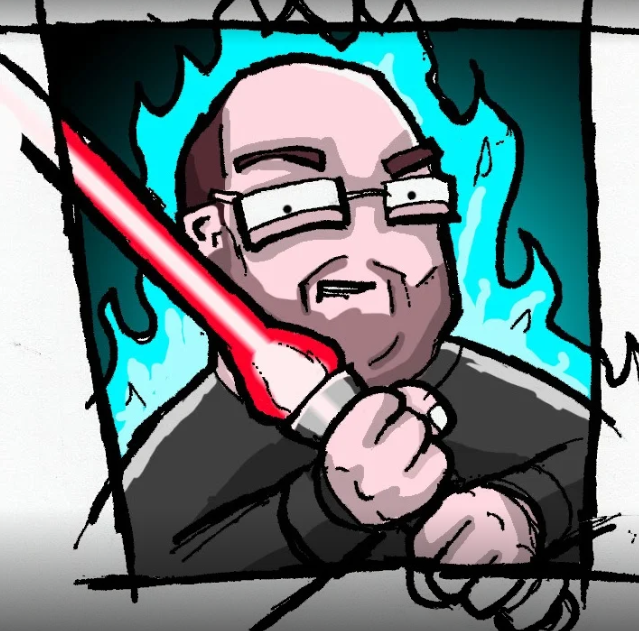Disco Elysium comes to life once the talking stops: ZA/UM details its approach to creating a truly expressive RPG
Disco Elysium's art director Aleksander Rostov details the art and animation behind one of 2019's best RPGs

For all its interesting dialogue, branching trees of responses and intertwining skill checks, nothing affected me more while playing Disco Elysium than when the second morning dawned on Revachol. My grubby, anti-social and perpetually hungover 'hero' shuffled to the edge of his bed, swung out his legs and, resting his elbows on his knees, put his head in his hands. In approximately three seconds of animation, I was told a wealth of information about the protagonist. His ills, his demons, and what ails him daily all fell into place. There's a slight shake of the head which I recognise as, "why won't the pain stop?". Each player will interpret this animation in different ways – there's no dialogue to parse, nor any interior thoughts which the game is noted to excel at – but this exhaustion is easy to read. We've all felt it.
Disco Elysium is a human story; beneath all of its many twists and turns, it tells of people struggling. While the script itself deserves heaps of praise, it's what happens in the moments between each beat of speech that helps define the weariness of the world. It's the small shuffle of feet shared between nervous acquaintances, the reclining chair of an aggressive antagonist, and the misting of breath in the cold, harsh air that sweeps through Revachol which helps to flesh out the cast and bring life to the location. "If the writers are putting in so much effort to bring these people to life, it would be criminal if the artists didn't attempt to match that effort," says Disco Elysium's art director, Aleksander Rostov.
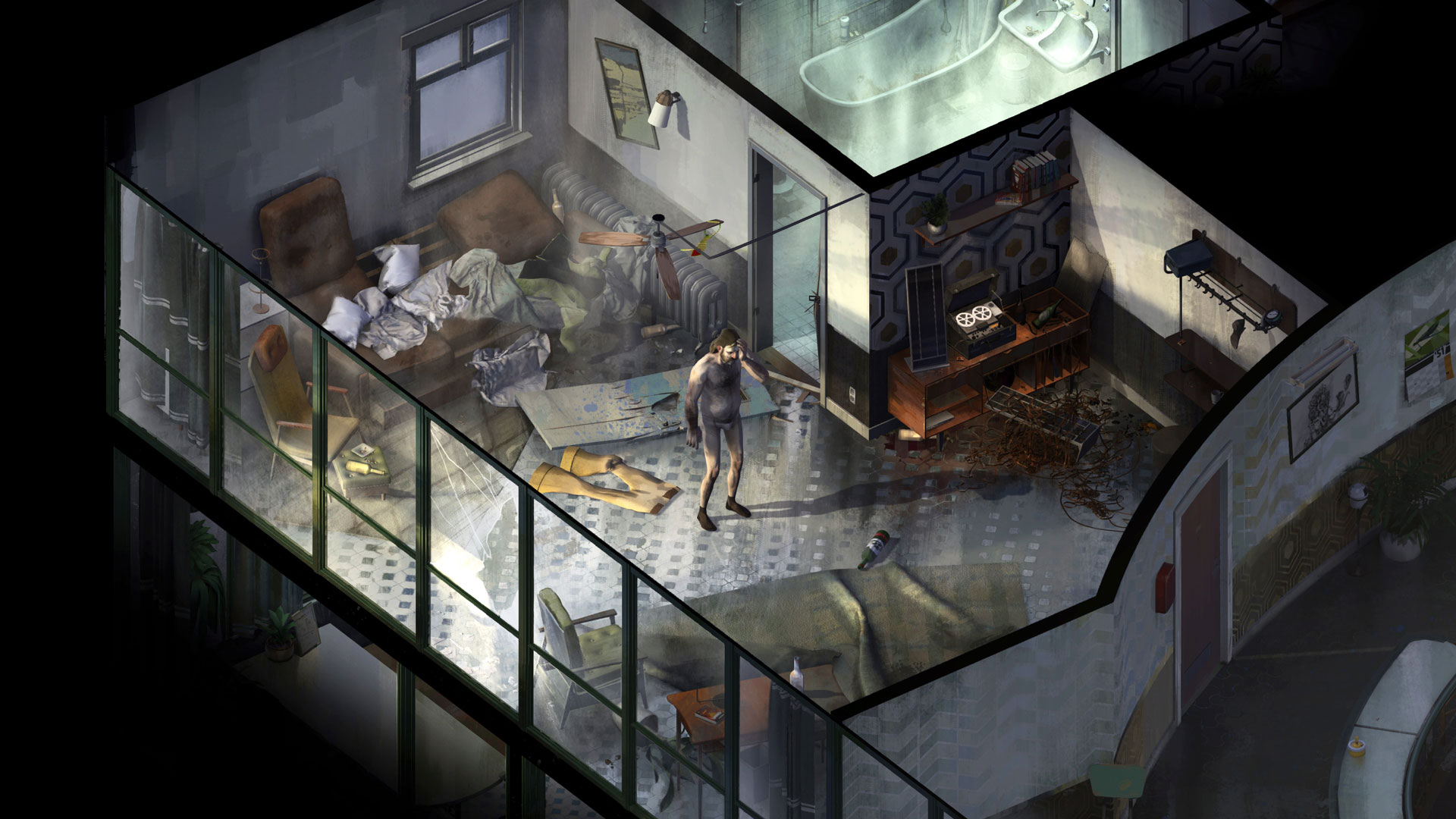
Disco Elysium plays on the idea of realism, albeit in a world that is completely disjointed from our own. What we see in the characters is recognisable, in stark contrast to a grimy and gritty world lavished with impasto strokes. "Hyperrealism is gauche," says Rostov, "embrace the artifice!" Breaking down the surreal, in order to view the humanism of the fictional world of Martinaise, Rostov took us on a journey through his inspirations.
"The thought really came into focus for me when I first saw one of the best movies ever made. House, a 1977 Japanese horror, which is a tour de force of what's possible with film cameras when you aren't trying to ape pure realism." Disco Elysium walks a fine line between the surreal art world and simulation. As players, we're given control of a cop whose entire personality can be built from our mouse clicks. Each experience will be broad; your first playthrough will likely be very different from that of a friend, built through layers and layers of numbers and spur-of-the-moment speeches.
The visuals of the game needed to reflect that, Rostov tells me, and that's just one of the reasons that developer ZA/UM pursued such an expressive art and animation style with Disco Elysium. "Hand painting the entire game was an obvious choice," Rostov continues, explaining that "[the] untethered art style fits with the story being told."
Reflecting reality

There's an early moment in the game where you can choose to approach two older men playing Boules. Following a certain path of dialogue allows the player to join the game and it's the stats chosen during character creation that will drive the actions taken when our cop picks up the Boule. Many will see him shot put the Boule into a nearby river, hefting his entire weight behind the ball, following through the toss, shoulders slumping as he realises his error. The older men quickly become agitated that their game has been ruined, doing their best to make you feel guilty for plunging their leisurely activity into the water. ZA/UM could have conveyed all of this through the script, but it's the way that the words meet the animation and art that really helps sell the situation. "At that point, the player's attention is on the text, and you're more likely to forgive if the character stops animating in tandem with the dialogue," Rostov explains. "In fact, then it becomes better to use animation sparingly in order not to split the player's attention. In situations where the animation is significant, the text tries to counterbalance itself and not duplicate what you've just seen, but instead comments on it."
The exaggerated movements accompany the tiny; for every large loping run, there's a shuffling toe of a small girl outside a bookshop. The surreal art style is integral to carrying the characteristics of the cast. Some will be noticed easily, like the swinging arm throwing a Boule or the drifting smoke of a cigarette in the dusk, others come not from animation but from subtle nuances in the stillness. Art, at its most basic, is about conveying emotion, allowing the artist to build a personality or scene which speaks to the viewer. Disco Elysium cleverly portrays its cast through changes in how they're physically depicted in the portraits beside their dialogue. "There are little bits all over the game, like the truck driver portraits show as their driver's licence ID photos. Whereas the moribund alcoholics' images literally dissolve into sloppy brushwork," remarks Rostov.
Weekly digests, tales from the communities you love, and more

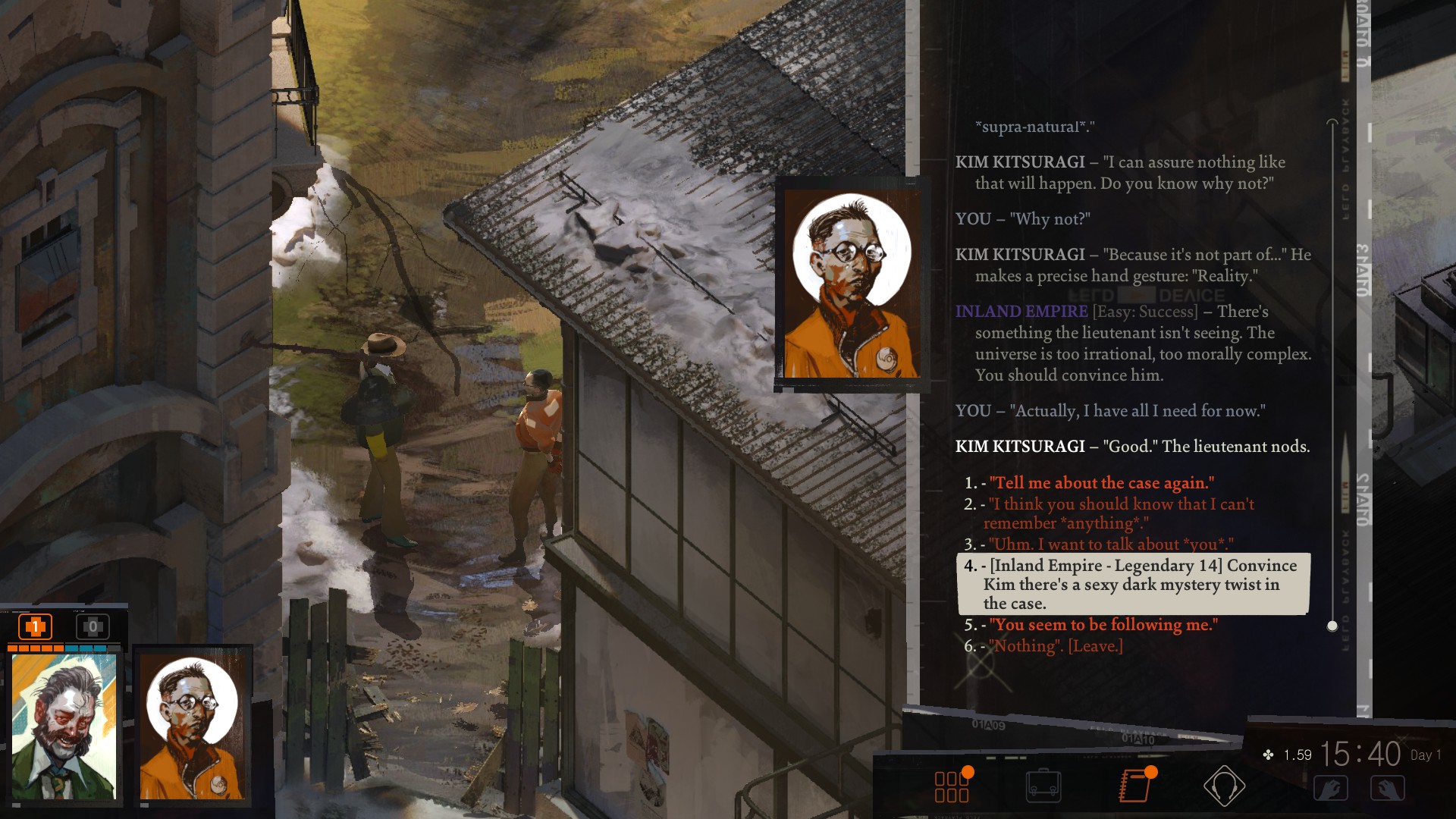
Disco Elysium is my game of the year because it made me care about a lost shoe: How ZA/UM's debut turns human failure into 2019’s best RPG
Striking that balance was something the art department was very aware of. Because most of the environments are painted, they had to implement the 3D elements where needed cleverly. "Lest the game feels like panning slowly over a JPEG," says Rostov. The world of Disco Elysium gives off the feeling that it is literally living and breathing, and much of that is drawn through the characters and the smalles of gestures. That said, Rostov is eager to have the player notice the surroundings also, tamping down the 3D aspects within the whole. "The world is populated with dried out piles of leaves from before Winter, unearthed from melting snow, gusts of wind blowing them around. There are discarded newspapers flapping in the wind, hanging fabric, trees and cables swinging back and forth." These add to the motion implied through the hand-painted visuals which our minds animate without direction from the game.
Despite the city of Revachol looking so distinctly different from our own world, much of the research for the characters was conducted in the art department office. Some sequences, which we won't spoil, required some hefty storyboarding, whereas the general movement of characters came from filming natural body language. "I fear there's a ridiculous pile of videos of me throwing my fist with a slumped back, giving up on life and love once and for all," laughs Rostov. Communication was key between the animators and writers, they were all very aware of how awkward the characters could look from the game's isometric perspective. "Eduardo Rubio, our lead animator, can really balance the knife's edge between a caricature of strong key poses and the subtlety of minute shifts in psychological stance."
Painting a picture
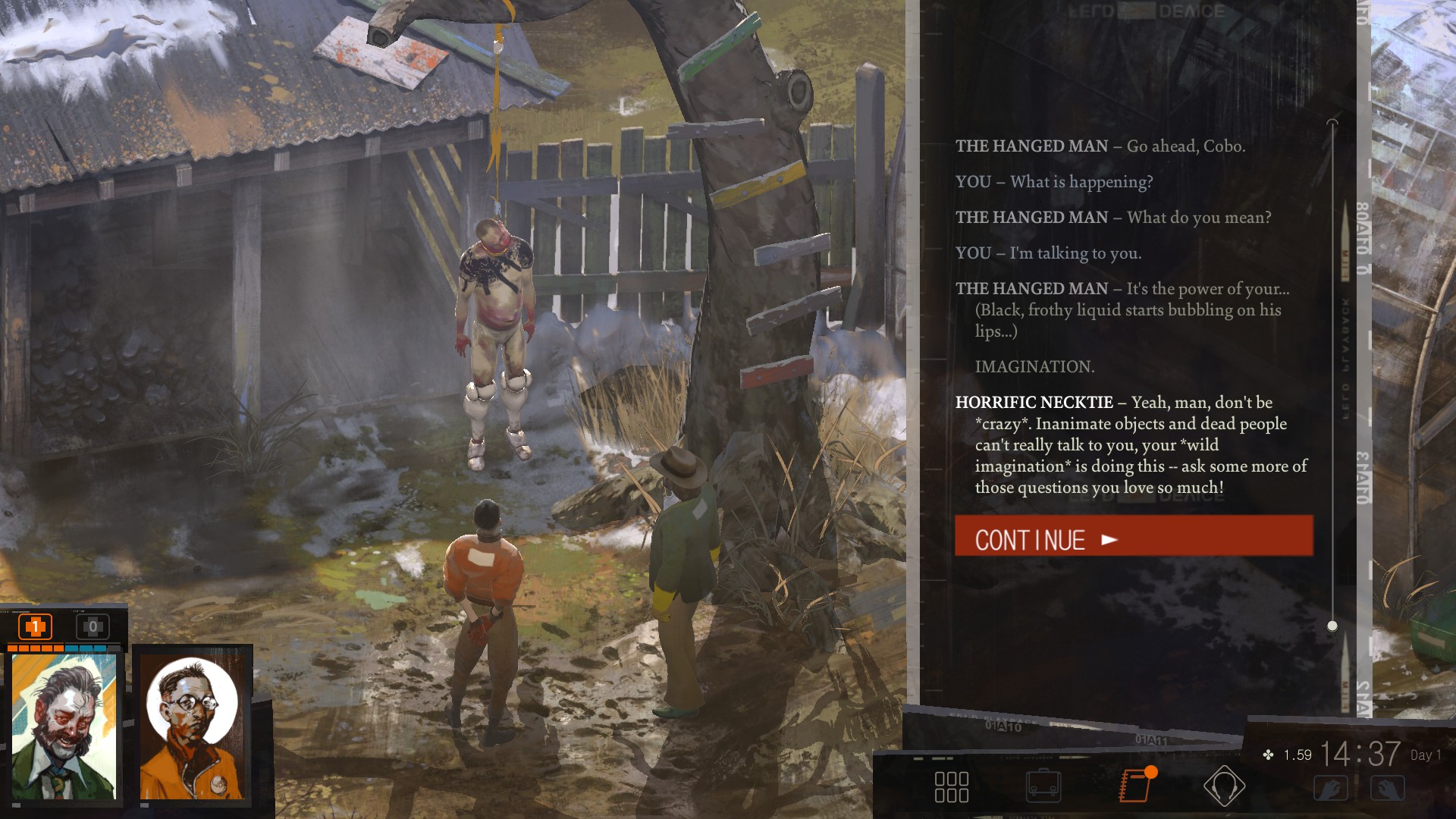
The right art style speaks volumes. Disco Elysium at times deals with complex emotions, the central game mechanic is built on interacting with aspects of our hero cop's personality. There's a constant sense of movement and change – jittery, unsure or as unbalanced as our cop can be. There's insanity in some images evoking Edvard Munch's 'The Scream', or erratic use of colour akin to a Rothko. The writers swing the cast through heartfelt melancholy to farcical attempts at flirting, each accompanied by an array of movements and expressions. The art and animation departments needed to keep up. There's a sense that, upon closing the game, the world of Martinaise and its citizens carry on living their lives. "I'm incredibly happy for this," Rostov continues. "To work on something like this with other people giving seven thousand per cent – safe in the knowledge that they have your back [and] aren't shitting the bed – to trust their judgement completely. It's pretty cool."
All of this means nothing if the environments don't compliment the writing. Martinaise is war-torn, broken down, and grungy. It reflects the people within as they are shown also worn down, drooping magazines in hands, slouching at balconies or with hands clasped to chests, protecting what's precious. Disco Elysium could never be set within a shiny metropolis, not only would the plot and cast stand out too much, but the sense of fluidity in the hand painting would fall flat – these movements noticed would become over-exaggerated. Martinaise is built on degrading opulence and the crumbling of "overindulgent monarchs". The studio wanted to emphasise the draining of vitality from the populace through the brutal architecture and room design.
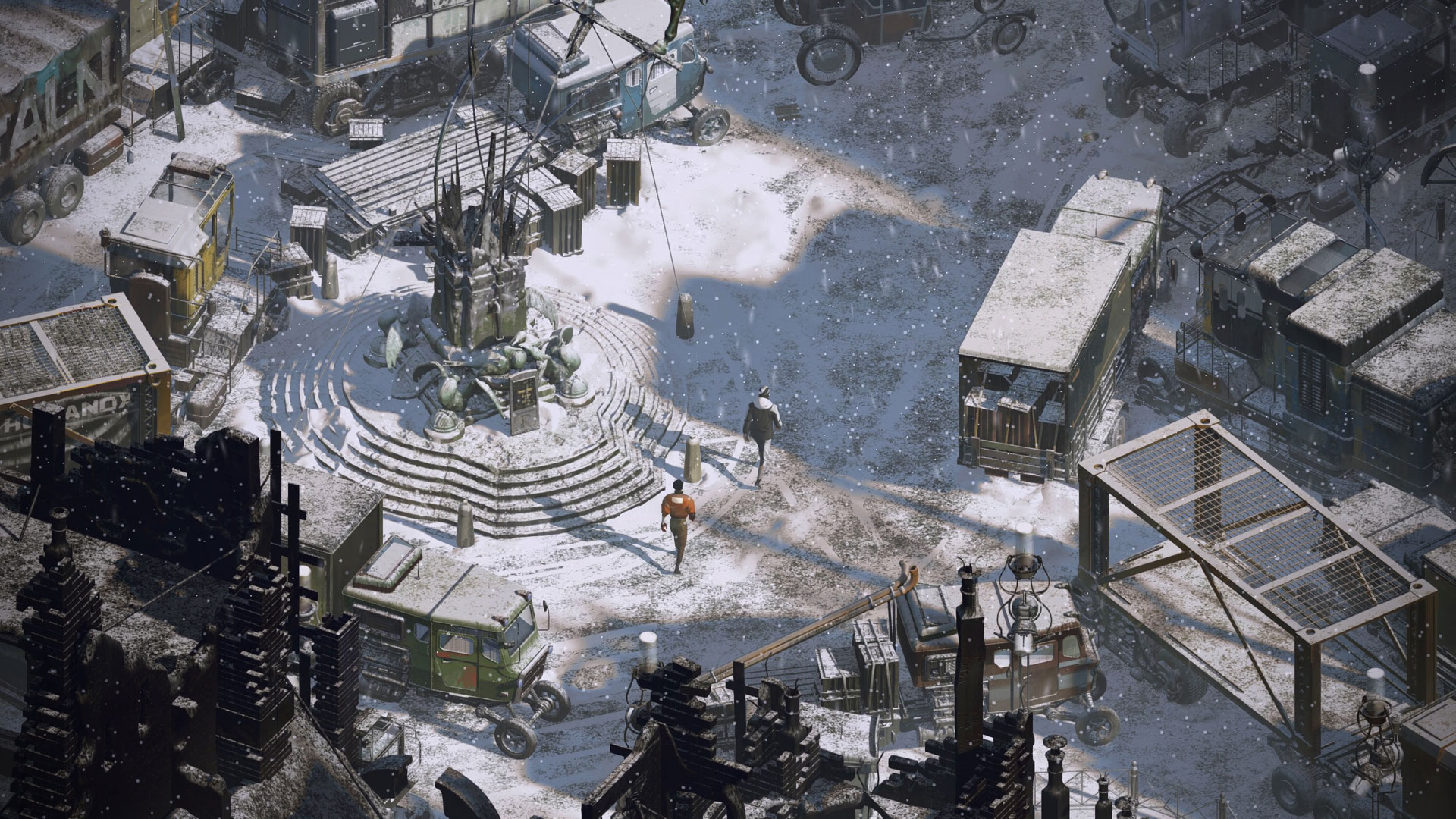
"As a police officer, you visit the homes of quite a few characters. Their homes are meant to be extended portraits. In a way, this is a game of portraits – the writer figures out the mannerisms and beliefs of the cast, the voice actor portrays this live through expression and enunciation, but the artist and animators get to portray their face and gestures." The passion for creating a fully realised world built on the tiniest of details is clear in Rostov and the game itself. Most of the details are things players won't actively notice, but dropped into the periphery, create an encompassing image. "The cat-shaped clock, the open umbrella in the corner. The home is a self-portrait of the character. The intent is to portray human hope in the middle of this all."
With all these teams working together, when the characters aren't talking, they're still communicating. Disco Elysium is a diorama full of bold and brazen personalities along with coy and guarded sorts. The passage of time is different here in Martinaise, away from the wider world where the player is based. The game feels like a constant march forward, towards something all-encompassing. But where the game gives players a moment of pause to decide on the best course of action, the game must breathe too. Rostov emphasises this by pointing out something not entirely obvious. "When you're sat in the main menu, time remains frozen. Aircraft apparently in motion simply hang still as if suspended in amber. Waiting for you to start the game and click on a dialogue option to pass another 23 seconds towards the inevitable entropic collapse of the world."
Disco Elysium is currently available on PC, although it will be coming to PS4 and Xbox One in 2020.
Dan has been playing games for over thirty years, from back when controllers had one button. Thankfully he has managed to keep up with his favourite hobby at his age. You can normally find him playing Roguelikes or Battle Royales, both of which are his specialist subject. When he isn't playing games, he's writing about them in books and articles. If he had to pick a favourite game, it would be The Binding of Isaac or Final Fantasy IX.
